History and exam
Key diagnostic factors
common
presence of risk factors
Key risk factors include obesity, female sex, smoking, and history of acne vulgaris or inflammatory bowel disease.
recurrent disease
Patients often report multiple trips to the emergency department and treatment with incision and drainage. Bacterial cultures usually do not identify a pathogenic organism.
poor response to previous antibiotic therapy
Most patients have been given short courses of antibiotics that do not affect the disease course.
open comedones in intertriginous (axilla, groin, perineum, or infra-mammary) areas
An important clue to the diagnosis of HS is the presence of multiple open comedones in intertriginous areas.
Axillary and inguinal areas are the most common sites for initial disease.[Figure caption and citation for the preceding image starts]: Hidradenitis suppurativa: open 'double' comedonesFrom R.A. Lee, MD, PhD [Citation ends].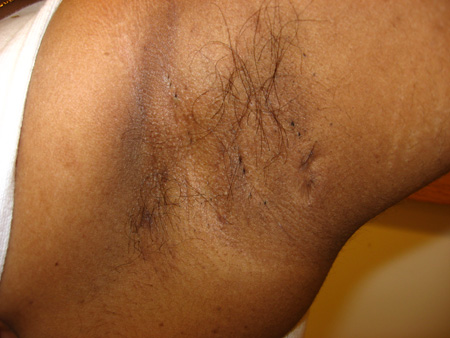
nodules or abscess
Inflammatory nodules may be present in the intertriginous areas (axilla, groin, perineum, or infra-mammary region). Fluctuant, tender nodules with purulent drainage are commonly present in patients with active disease. [Figure caption and citation for the preceding image starts]: Hidradenitis suppurativa stage I: discrete inflamed nodules and papules with intervening normal skin and lack of scarringFrom R.A. Lee, MD, PhD [Citation ends]. [Figure caption and citation for the preceding image starts]: Hidradenitis suppurativa stage II: inflamed nodules and scars with areas of intervening normal skinFrom R.A. Lee, MD, PhD [Citation ends].
[Figure caption and citation for the preceding image starts]: Hidradenitis suppurativa stage II: inflamed nodules and scars with areas of intervening normal skinFrom R.A. Lee, MD, PhD [Citation ends].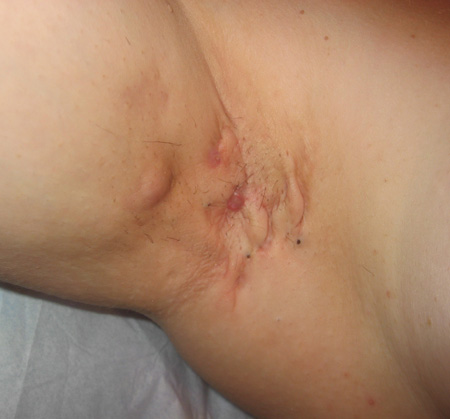 [Figure caption and citation for the preceding image starts]: Hidradenitis suppurativa: fluctuant abscess in axillaFrom R.A. Lee, MD, PhD [Citation ends].
[Figure caption and citation for the preceding image starts]: Hidradenitis suppurativa: fluctuant abscess in axillaFrom R.A. Lee, MD, PhD [Citation ends].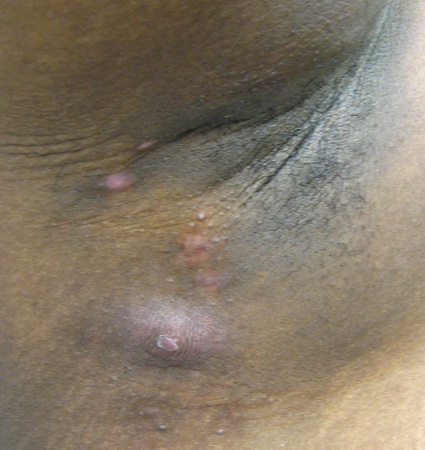
symmetrical distribution
Although unilateral lesions can present early in the disease course, bilateral involvement is the natural course of the disease.
Persistent unilateral disease warrants consideration of other aetiologies.
sinus tracts with scarring
Linear, cord-like scars with purulent drainage are characteristic of HS. Usually seen in advanced disease. [Figure caption and citation for the preceding image starts]: Hidradenitis suppurativa: linear scarsFrom R.A. Lee, MD, PhD [Citation ends].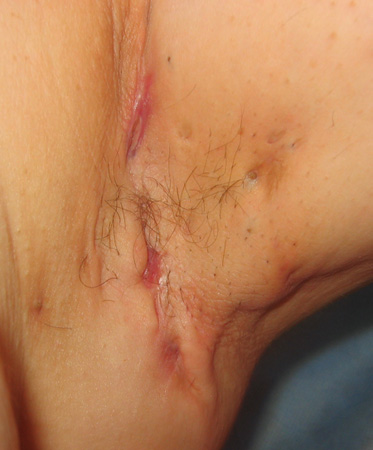 [Figure caption and citation for the preceding image starts]: Hidradenitis suppurativa: draining sinus tractsFrom R.A. Lee, MD, PhD [Citation ends].
[Figure caption and citation for the preceding image starts]: Hidradenitis suppurativa: draining sinus tractsFrom R.A. Lee, MD, PhD [Citation ends].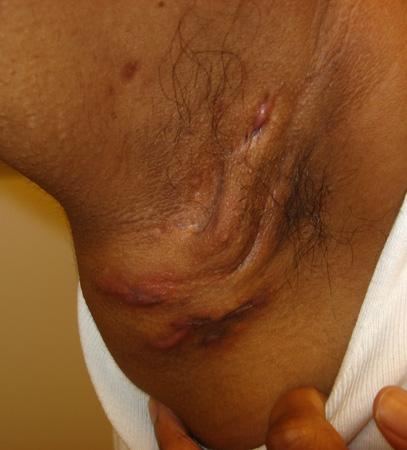
Other diagnostic factors
common
premenstrual flare
Many women report that tenderness and swelling begin about 1 week prior to the onset of menses, suggesting a potential role for androgens in HS pathophysiology.[35]
Risk factors
strong
obesity
smoking
Meta-analyses have found that HS is significantly associated with active smoking and a history of smoking.[21][26] A large retrospective cohort study reported that HS incidence is doubled among tobacco smokers.[27]
Nicotine increases inflammation and may promote bacterial colonisation of intertriginous areas, chemotaxis of inflammatory mediators, and hyperplasia of the infundibular epidermis, thereby contributing to the disease process.[19][28]
positive family history
Use of this content is subject to our disclaimer